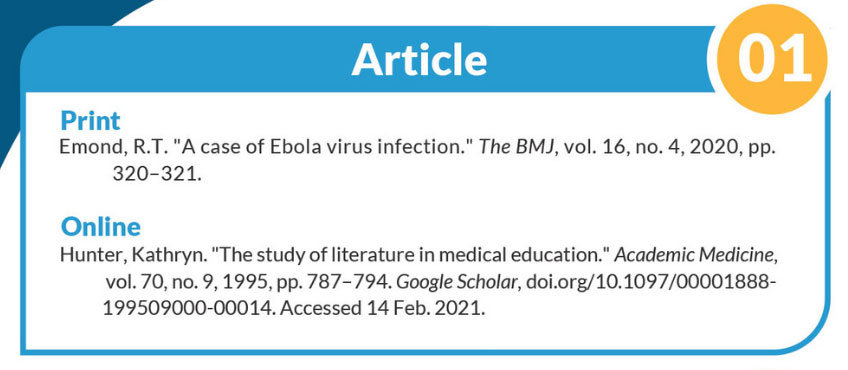
Your instructor has asked you to format your term paper using Modern Language Association (MLA) style. You feel confident enough to produce the paper, but you have never heard of MLA style. Don't panic—we've got you covered.
This article will explain MLA style citation, give examples of MLA formatting for specific aspects of references, provide an MLA format example for each category of source material, and share essay formatting tips that our editors have learned over the years.
You'll even find a free, downloadable MLA Works Cited example page for easy reference. So, if you have a general understanding of what MLA style is and are just looking for examples of MLA citations, we can help with that too!
MLA style is an accepted way to document source material for many types of humanities documents. Some would say it is simpler than other style guides, such as the APA Style Guide or the Chicago Manual of Style .
An MLA citation has two basic requirements:
In simple terms, you refer to your source material in parentheses throughout the main text—then, at the end of your paper, you list all the sources to which you have referred, in alphabetical order.
Of course, there is so much more to MLA style and MLA formatting than just that. Indeed, the current version of the MLA Handbook for Writers of Research Papers (7th Edition) runs to 292 pages! But here are the essential style and formatting points.
To start, let's look at a basic example of how to format a citation in MLA.
Last Name, First Name. "Title of Webpage/Chapter/Article." Website/Book Title/Journal Title , edition used, vol. X, no. Y, Publisher,
Day Month Year of Publication, URL/location/page number.
This is MLA format at its simplest.
The main reason for carefully citing source material is to avoid allegations of plagiarism, which—derived from the Latin word for "kidnapping"—refers to stealing someone else's work. The MLA Handbook explains plagiarism in detail. You should feel free to use another person's words, facts, and thoughts in your research paper, but the material you borrow must not be presented as if it were your own creation.
When you write your research paper, remember that you must document everything that you borrow—not only direct quotations and paraphrases but also information and ideas. Our MLA citation guide will walk you through how to properly cite your sources using MLA style.
MLA-style citation is commonly used by writers and students who create content in the humanities.
You'll often see it used for the following subject areas:
Using MLA's citation guide in these fields of study gives readers an easier option for navigating through your paper. In addition to making you look credible by neatly organizing your sources, MLA citation lends consistency to your work. It provides readers with the opportunity to easily find sources in your paper that interest them.
The early stages of producing a paper involve copious amounts of reading, research, and note-taking. At this point, it's easy to get confused about who said what. The best way to avoid getting confused right from the start is to keep your ideas, your summary of others' ideas, and direct transcriptions of text clearly marked and separate. Throughout our guide, we'll provide examples of MLA citation to give you a hand.
Make notes on the following elements for ease of reference and proper MLA citation later on:
Laying the groundwork during your research will make the citation process much easier later on.
Because we know there are many ways to cite a reference in MLA, depending on what source you're using, we've compiled an extensive list of MLA citation examples below.
You'll find MLA citation examples for articles, books, images, interviews, journals, movies, and more to ensure you are citing your sources correctly.
We've done our best to be as thorough as possible. Review how to use in-text citations in MLA below or skip to the ones you need most!
If you're citing a book in MLA format with two or three authors, use the examples below to format your citation:
Bringham, Darrin E., and Sally Knope. Resting Heartbeat Science . 12th ed., Wiley, 2001.
Christopherson, Charles, Ronald Swanson, and Roger Koltz. Fog Pirates: On Board the USS Hammerhead . Putters, 2001.
Only the first author is listed by their last name followed by their first name. Any subsequent authors are written normally (first name then last name).
When there are more than three authors to reference in MLA, format your citation using et al., as shown below:
Niderbacher, Leslie A., et al. Penne and the Jets: A Love Story . Partridge, 2003.
Note that only the first author is fully named, followed by et al.
An MLA in-text citation with no author begins with the title . If your in-text citation has no author in MLA, you can also use the title in addition to the page number.
( Encyclopedia of Football 54)
Correct MLA article citation starts with finding good, credible articles. Try looking for peer-reviewed scholarly journal articles in free research databases such as CORE and ScienceOpen.
When searching for the best journals for your topic, try to steer clear of regular search engines like Google or Yahoo. Academic databases like JSTOR and Google Scholar are the best sources for scholarly, peer-reviewed articles .
MLA journal citation elements include the title of the work, author(s), and publication date. While this information is usually found on the first page of an article, its placement can vary. It may be at the top or bottom of the first page or, in the case of database articles, on the results page or the description page.

Lau, Frank. "Vitamin D Insufficiency is Prevalent in Severe COVID-19." Journal of Health , vol. 2, no. 5, Aug. 2020, pp. 34–27.
Kuehn, Bridget. "Hospitals Turn to Housing to Help Homeless Patients." JAMA , Feb. 2019, pp. 5–9.
Tomky, Naomi. "Explore the Oregon Coast—but don't touch the 'dragon toes.'" National Geographic , 23 Mar. 2022,
Gateley, Cheyne. "Netflix's Password Crackdown Will Be Tougher Than It Seems." Variety , 21 Mar. 2022,
If you're citing passages from a book using MLA, look at the title page of the book to find the information you need to cite the source. The title page can usually be found a couple of pages into the book. This is where you'll find the author(s), date, edition, title, editors (if any), place of publication, and publisher.
Schucman, Helen. A Course in Miracles. Edited by Robert Perry, The Circle of Atonement, Inc., 2017.

Image citation in MLA requires you to first define what type of image you're sourcing. Is it an image you saw in person or an image from a website?
Asking yourself this question first will help you decide which format to use to cite your image. Let's look at a few examples below.

How to Cite an Image from a Website
To cite an image from a website in MLA, start with the image creator's last and first name, then add the image title, the website name , day, month, and year published, and the URL.
In the example below, there is no image title, so we're using a description of the image:
Yam, Marcus. Photograph of a man hurrying away from a building hit by Russian bombs. Los Angeles Times , 25 Mar. 2022,
Here is an example with an image title:
Clancy, Pat. "Foggy Sunrise." Flickr , 10 Mar. 2022,
When citing an interview in MLA, the information you need can vary depending on the type of interview.
For example, if you're citing an interview printed in a magazine, you can find relevant citation information in the title or subtitle of the interview page.
For online interviews, the relevant information can be found on the site where the interview was published. Typically, in the title or near the name of the person who published the interview, you'll find the names of the interviewer and interviewee, as well as the date the interview was published.
Here are a few elements you'll need if you're citing an interview in MLA:
In MLA, if you can't find the author of an interview you're trying to source, this information can be skipped. Instead, you can start your citation with the title of the interview in quotation marks. You can also skip the date of the interview if it is missing, but you should still include the access date if the interview is online.
If, for any reason, you also can't access the title of the interview, MLA allows you to replace the title with a short description. Let's look at a couple of examples below.

When citing a lecture in MLA, start with the speaker's last and first names, followed by the lecture title in quotes, then the course or event name, the day, month, and year, the institution, the location, and the word "Lecture." Below is an example of how to cite a lecture in MLA.
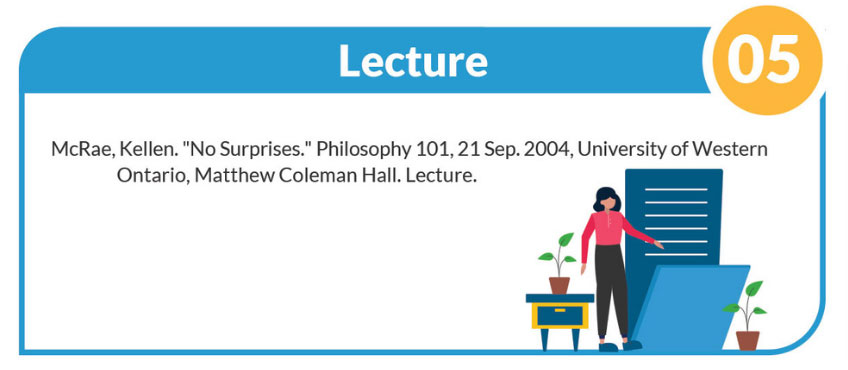
If you need to cite a movie in MLA style, you'll need the title of the film, the director, any relevant contributors, the company that produced/distributed the film, and the release year. Be sure to add the words "Directed by" before the director's name, as you'll see in the examples below.
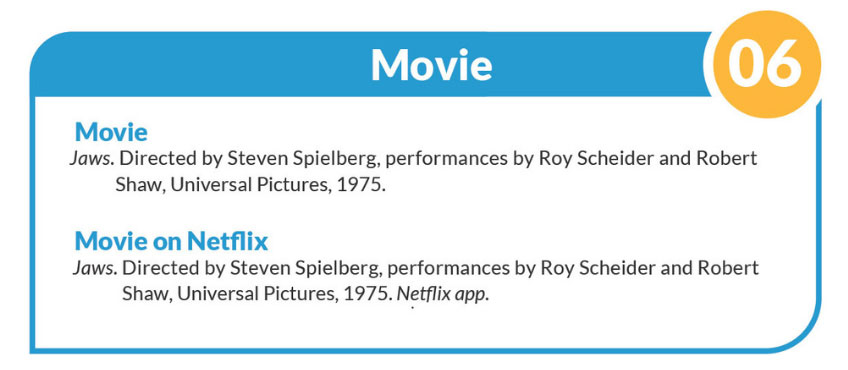
To cite a poem in MLA, begin with listing the author's last name and first, then the poem's title in quotes, followed by the title of the book the poem was found in, and the publisher, year, and page number(s).
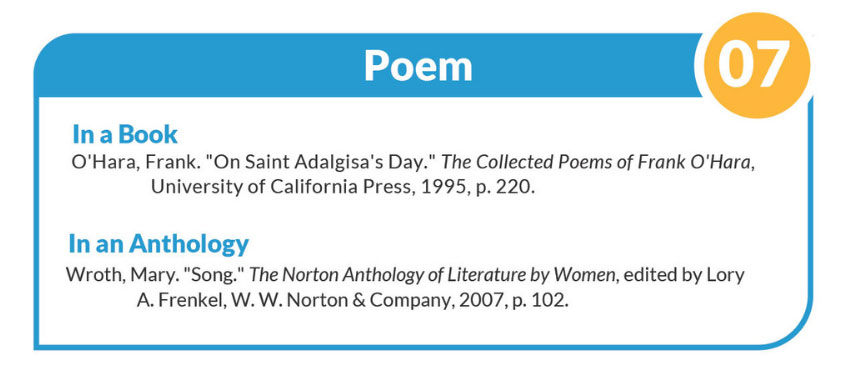
When you're using a quote, you're taking the exact words from an original source, so you need to make sure you're citing that source correctly.
In MLA format, quotes should be cited in the main text and on the Works Cited page. Your in-text citation will need the author's last name and the page number where you found the quote , while the Works Cited page will include the full citation. We've included examples of both MLA quote citation formats below.
In-text citation example:
It appears that creating "businesses that diminish the quality of life and well-being of our citizens" (Williamson 109) will only make things worse.
Works Cited example:
Williamson, Marianne. A Politics of Love . Harper One, 2019.
If you have to cite quotes longer than four lines in your paper, you'll want to use a block quote. The MLA format is the same on the Works Cited page for long and short quotes, but block quotes look different in the main text.
Block quotes are placed in a separate paragraph, indented 1 inch from the left margin. When using a block quote in text, include the last name of the author and page number(s) in parentheses after the closing punctuation at the end of the quote.
Note that block quotes are not enclosed in quotation marks.
When citing a song in MLA, pay close attention to the medium you used to access it. If you heard the song on a CD or on a streaming service like Spotify, you'll want to include this in your reference.
For in-text citations of songs, you'll include your citation at the end of your paraphrased portion with the last name of the performer and the specific time stamp of the song. Other elements needed for the citation on the Works Cited page include the album name, label, and release date.
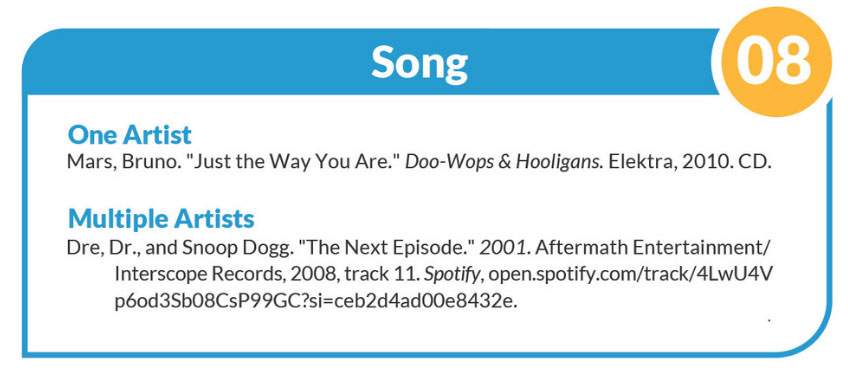
An MLA citation for a YouTube video requires a few pieces of information, including the video creator's name, the title of the video, the website hosting the video, the name of the channel or uploader, the day, month , and year the video was published, and its URL.
Regardless of the platform from which you cite a video, MLA requires the same standard information, including the creator of the video, the title, where it was found, who uploaded it, the day, month, and year it was uploaded, and the URL.

How to Cite a Website in MLA
The MLA format for websites requires a few core elements, including the author, title of the source and container, relevant contributors, version, publisher, publication date in day-month-year format, and DOI or URL .
Some of this information can be omitted if it isn't available. See the examples below.
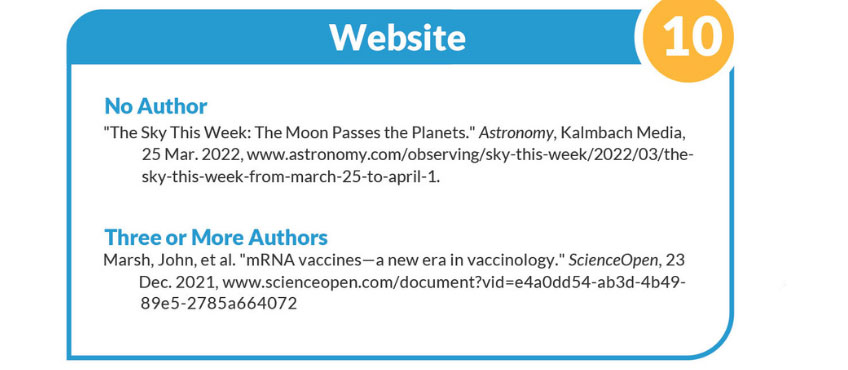
When you're writing a paper in MLA format, headings go on the first page . Your heading should include the following information:
Your MLA heading goes in the upper left corner of your paper, double-spaced. Try not to confuse an MLA heading with an MLA header, which is in the upper right corner of every page of your paper and includes your last name and the page number.
Here are two example headings in MLA format for reference. Keep in mind that these should be double-spaced in your paper.
25 February 2021
In the next few sections, we'll look at MLA formatting for sources cited within the main text of your paper, also called in-text citations. In-text citations give your reader a clue about where to find the source you referenced in the Works Cited section at the end of your paper.
MLA format for books requires that you briefly acknowledge your sources in the main body of the text by using the author's name and the page number in parentheses.
Note the following example:
The reader knows to consult page 440 of Clinton's book.
If you refer to the title of a large published work in your paper, such as a novel or movie, it should appear as follows:
John Clinton's A Study of Life.
Please note the use of capital letters and italics.
Titles of smaller works, such as poems, short stories, chapters, and articles, should be written in the text as follows:
Raymond Carver's "Cathedral."
Please note that smaller works are put in quotation marks and are not italicized.
To obtain further information, the reader can refer to the alphabetical references section, called the Works Cited page, at the end of the paper. There, the reader can find the full details of each cited publication.
Note the following MLA Works Cited example:
Clinton, John. A Study of Life . London: Hodder, 1998. Print.
Our John Clinton example is MLA style referencing in its simplest form: one author and one book. MLA citation for multiple authors of a single book and MLA citation for multiple books by a single author tend to complicate matters. However, if you have the basics right and have made good notes for all your source material, these problems are manageable.
When citing two or more books by one author in your Works Cited section, MLA requires the author's name in the first entry only. In the next entry, replace the author's name with an em dash (—), a period, and the second book title. The em dash takes the place of the author's name. In terms of the order of the books by one author on your Works Cited page, alphabetize the list by title.
Brunson, Russell. DotCom Secrets . Morgan James Publishing, 2015.
—. Traffic Secrets . Hay House, Inc., 2020.
When citing three or more authors in MLA, you'll want to use "et al.," which means "and others."
Levine, Robert S., et al. The Norton Anthology of American Literature . 9th ed., W.W. Norton & Company, 2022.
If you're trying to cite a source in MLA with missing information, you have a few options available to you depending on what information is missing.
If you're missing the author of a source, use the title of the work in its place for both in-text citations and citations in the Works Cited in MLA format. If your title is also missing, use the source instead.
If your source has no page numbers, you can omit these in your citations and use paragraph or line numbers if they are available.
If the date of the publication is missing, you don't have to include it. But if it's a resource you accessed online, include the access date at the end of the citation—for example, "Accessed 14 Sep. 2021."
You can also omit the publisher if this information is missing.
When formatting your Works Cited page in MLA format, be sure to pay close attention to all the guidelines. MLA requires all lines to be double-spaced with a hanging indent. A hanging indent is when the first line of your reference starts at the beginning of the line while the next lines are indented by an inch and a half from the left.
To keep all of these MLA examples in one sheet for easy reference, we've compiled a free download. This way, you can review MLA citation examples anytime you need them, either for your Works Cited page or in-text citations, for multiple types of work.
Once downloaded, you'll have all of the MLA citation examples you need in your back pocket. This guide will give you examples of MLA citations for the following types of sources:
Download our free MLA downloadable here.
When writing a paper in MLA format, you'll need to cover your bases when it comes to citing your sources. Not only do your sources need to be correct to account for wherever you're pulling information from, but they also need to follow MLA paper formatting basics .
So far, we've covered how to cite sources in your Works Cited list and in-text citations. Now, let's talk about how to use footnotes in an MLA paper with a couple of examples.
As a general rule, footnotes should be used sparingly in MLA. However, when they are used, there are two types: bibliographical footnotes and content footnotes.
Bibliographical footnotes allow you to add more relevant sources. Content footnotes allow you to add commentary or explanations about your topic. We'll look at examples of both of these below.
1 See Clinton, John. A Study of Life . Hodder, 1998. Additional references are for this edition and appear within the text.
1 In a lecture from 2013, Peters mentions his love of science and how science will shape our future.
The MLA format cover page is not an entirely separate page. It begins with a 1-inch margin, flush left with your name, your instructor's name, the course name or number, and the date typed on separate, double-spaced lines.
The title of your research paper should then be centered on the MLA format title page. There is no need for it to be presented in bold, italics, or capital letters.
When citing a source in your text in MLA, use a parenthetical citation.
Parenthetical citations in MLA should include the author's last name and the page number where you found the information.
For example: (Lars 86).
In MLA format, page numbers appear in the top right-hand corner with a 0.5-inch margin from the top and a flush right margin. It is good practice to include your last name before the page number in case pages go astray. Do not use the abbreviation p. before the page number or add any other mark or symbol. You may not need to include a page number on the front page—check with your instructor.
Sometimes, it is appropriate to draw attention to particular words in your paper, but using italics for emphasis ("He really ate a lot ") is inappropriate in research writing and inconsistent with MLA style. Generally, in MLA format, italics should be reserved for titles of longer works (e.g., books, films), non-English words, and words and letters referred to as words and letters.
Your instructor may issue particular instructions if you are to use MLA citation in an essay—if so, follow them. Otherwise, the following MLA essay formatting tips will help you set out your research paper in MLA style.
The MLA Style Guide recommends using a clear typeface (Arial or Times New Roman) in a readable size (at least 11 point).
Justify the text to the left margin, leaving the right margin ragged. Leave 1-inch margins on the top, bottom, left, and right of the page.
Indent the first word in each paragraph by 0.5 inches. Indent set-off block quotations by 1 inch.
Use double-spacing throughout. In accordance with the MLA guide, use single spaces after periods, commas , exclamation marks, etc.
Good grammar, punctuation , and spelling are essential parts of your research paper—not just when using MLA style citation. There is no room for typos at this level.
Our advice is to check and check again, and don't just rely on your word processor's spell-checker. Get a second pair of eyes to look over your paper. T ry our essay editors to ensure that the MLA formatting is consistent throughout your paper and there are no grammatical errors.
The importance of citing your references in your essay cannot be understated. Any time you include a piece of information in your essay that you didn't write yourself, MLA requires two forms of citation: one in the main text and one at the end of your paper in the Works Cited section.
To see how all these formatting elements come together to make an MLA paper, see the example below.
In this computerized age, electronic publications are widely used as source materials for essays. However, electronic texts are prone to frequent and rapid change—one minute you see them online, and the next they are gone. Therefore, it is important to provide more information when references to electronic works are made.
When accessing electronic information, note the following elements:
Note the following example of MLA citation:
Smith, George. "Trees of the Southern Hemisphere." The International Leaf. Barker University, 2008. Web. 6 Feb. 2009.
Please note that the MLA formatting and style guide no longer recommends including the URL of a document. Nevertheless, the URL can be included if it is required by your instructor or if your readers will have difficulty locating the source without it.
Below, you'll find examples of how to apply the MLA letter format. Much of the formatting will be similar to that of MLA-style papers, including using double-spaced lines in your text.
Start your MLA-formatted letter with your two-line mailing address in the upper left-hand corner, an inch from the top of the page. Skip to the next line and add the date in day-month-year format.
On the next line, include the addressee's information, starting with the recipient's title, such as Mr., Ms., or Dr. You can also include their address and contact information.
On yet another line, include your salutation—for example, "Dear Ms. Smith"—followed by a colon. If you don't have a name for the person you're writing to, use the person's title—for example, "Dear Director of Operations."
When writing a letter in MLA format, be sure to use double-spacing throughout as you would in an MLA paper.
The formatting of citations varies among style guides like Chicago, MLA, and APA. While each style guide has its own way of formatting sources and cover pages, one of the biggest differences is in how they format in-text citations. Let's look at how they differ.
MLA stands for the Modern Language Association and is a style used for papers in the humanities. In-text citations in MLA use the author's last name and page number in parentheses: (Smith 15).
APA stands for the American Psychological Association and is a style used for scientific papers. In-text citations in APA style include a bit more information than those in MLA style. For example, APA uses the author's last name, year of publication, and page number: (Smith, 2021, p. 15).
Chicago style is used mainly for manuscripts by writers, designers, and publishers. In-text citations in this style include the last name of the source, the publication year, and the page number in parentheses, with slightly different formatting than APA: (Smith 2021, 15).
To cite a website in MLA, start with the author's last name and first name separated by a comma and punctuated with a period. Next, include the title of the article or page in headline case and in quotes with a period, followed by the title of the website in italics. After that, add a comma, the name of the publisher, the publication date in day-month-year format, and the URL.
Shields, Ronan. "'The Threat is Hollow': True Transparency is Some Way Off for Scaled Advertisers." Digiday , Digiday Media, 25
Mar. 2022, https://digiday.com/marketing/the-threat-is-hollow-true-transparency-is-some-way-off-for-scaled-advertisers/.
Basu, Tyler. "How to Build a Personal Brand (Complete Guide)." Thinkific , Thinkific, 7 Sep. 2021,
For an MLA website in-text citation, simply put the last name of the author in parentheses: (Shields).
The MLA citation for a journal article begins with the author's last name and first name separated by a comma. Next, include the title of the article in quotes, punctuated by a period, then the journal title in title case and italics, and then a comma before the volume or issue number. This is followed by the date of publication, the page range, and the DOI or URL (without https://). Finally, add the access date if no publication date is listed.
Lau, Frank. "Vitamin D Insufficiency is Prevalent in Severe COVID-19." Journal of Health , vol. 2, no. 5, Aug. 2020, pp. 34–27.
Kuehn, Bridget. "Hospitals Turn to Housing to Help Homeless Patients." JAMA , Feb. 2019, pp. 5–9.
In-text citations allow readers to identify which of the items on your Works Cited page you're referencing. MLA requires the source's last name to be set in parentheses, followed by the page number where you found the information. Below are a few examples of how to use in-text citations in MLA format.
For MLA YouTube citation, start with the video creator's last name and first name, separated by a comma and punctuated by a period. Next, include the title of the video in quotes, also punctuated by a period (inside the quotation marks).
Add the website hosting the video in italics (in this case, YouTube), the name of the channel or uploader, and the day, month, and year the video was published. Include the URL at the end of the MLA video citation.
Forleo, Marie. "Can You Age in Reverse? Tony Robbins Says Yes." YouTube , uploaded by Marie Forleo, 14 Feb. 2022,
Snipes, Doc. "15 Tips to Stop Ruminating and Get Out of Your Head." YouTube , uploaded by Doc Snipes, 23 Mar. 2022,
Put your MLA heading in the upper left-hand corner of the first page of your paper , double-spaced. It should have your name, your instructor's name, the course name or number, and the date. Here are two examples of how to format your headings in MLA:
25 February 2021
To cite a movie in MLA style, start with the title of the film in italics, then the name of the director, followed by any relevant contributors. Next, include the company that produced or distributed the film and the release year.
Jaws . Directed by Steven Spielberg, performances by Roy Scheider and Robert Shaw, Universal Pictures, 1975.
To cite a movie from a streaming service such as Netflix, use the following format:
Jaws . Directed by Steven Spielberg, performances by Roy Scheider and Robert Shaw, Universal Pictures, 1975. Netflix app.
To recap the most important MLA formatting guidelines, be sure to use 1-inch margins all around your paper, set the font to 12-point Times New Roman (or another easy-to-read font), and double-space the lines in your text. Make sure each word at the start of your paragraphs is indented half an inch from the left margin, and do the same for any block quotations.
You must cite all your sources in MLA, both in the text and on the Works Cited page found at the end of your paper. Use the examples and guidelines above to make sure you're formatting your paper and citations according to MLA guidelines.
If you're citing an interview, use the last and first name of the person interviewed at the start of your MLA Works Cited citation. Then, add the interview title, periodical title, type of interview, date, and URL of the interview (if online).
If the person you're referencing was interviewed in print, include the page numbers.
For an in-text citation of an interview, use the last name of the person being interviewed—for example: (Smith).
Download our free MLA format PDF for more examples of how to cite a person in MLA for an interview, either one you've conducted yourself or one you found elsewhere.
Free MLA Cheat Sheet
Scribendi's in-house editors work with writers from all over the globe to perfect their writing. They know that no piece of writing is complete without a professional edit, and they love to see a good piece of writing transformed into a great one. Scribendi's in-house editors are unrivaled in both experience and education, having collectively edited millions of words and obtained nearly 20 degrees. They love consuming caffeinated beverages, reading books of various genres, and relaxing in quiet, dimly lit spaces.